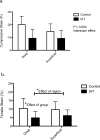Insertional achilles tendinopathy associated with altered transverse compressive and axial tensile strain during ankle dorsiflexion
- PMID: 27306527
- PMCID: PMC5738911
- DOI: 10.1002/jor.23338
Insertional achilles tendinopathy associated with altered transverse compressive and axial tensile strain during ankle dorsiflexion
Abstract
The purposes of this case-control study (N = 20) were to examine the effects of insertional Achilles tendinopathy (IAT) and tendon region on tendon strain in patients with IAT compared to a control group without tendinopathy. An ultrasound transducer was positioned over the Achilles tendon insertion during dorsiflexion tasks, which included standing and partial squat. A non-rigid image registration-based algorithm was used to estimate transverse compressive and axial tensile strains of the tendon from radiofrequency ultrasound images, which was segmented into two regions (superficial tendon and deep). For transverse compressive strain, two-way mixed effects ANOVAs demonstrated that there were interaction effects between group and tendon region for both dorsiflexion tasks (Heel lowering, p = 0.004; Partial squat, p = 0.008). For axial tensile strain, the IAT group demonstrated a main effect of lower tensile strain than the control group (Standing, p = 0.001; Partial squat, p = 0.033). There was also a main effect of greater tensile strain in the superficial region of the tendon compared to the deep during standing (p = 0.002), but not during partial squat (p = 0.603). Reduced transverse compressive and axial tensile strains in the IAT group indicate altered mechanical properties specific to the region of IAT pathology. Additionally, patterns of compressive strain are consistent with the theory of calcaneal impingement contributing to IAT pathology. © 2016 Orthopaedic Research Society. Published by Wiley Periodicals, Inc. J Orthop Res 35:910-915, 2017.
Keywords: Achilles tendonitis; heel lift; tendon mechanics; ultrasound elastography.
© 2016 Orthopaedic Research Society. Published by Wiley Periodicals, Inc.
Figures



Similar articles
-
Ultrasound strain mapping of Achilles tendon compressive strain patterns during dorsiflexion.J Biomech. 2016 Jan 4;49(1):39-44. doi: 10.1016/j.jbiomech.2015.11.008. Epub 2015 Nov 30. J Biomech. 2016. PMID: 26655590 Free PMC article.
-
Altered tendon characteristics and mechanical properties associated with insertional achilles tendinopathy.J Orthop Sports Phys Ther. 2014 Sep;44(9):680-9. doi: 10.2519/jospt.2014.5369. Epub 2014 Aug 7. J Orthop Sports Phys Ther. 2014. PMID: 25103130
-
Ultrasound strain mapping of the mouse Achilles tendon during passive dorsiflexion.J Biomech. 2022 Feb;132:110920. doi: 10.1016/j.jbiomech.2021.110920. Epub 2021 Dec 20. J Biomech. 2022. PMID: 34998182 Free PMC article.
-
Biomechanics and pathophysiology of overuse tendon injuries: ideas on insertional tendinopathy.Sports Med. 2004;34(14):1005-17. doi: 10.2165/00007256-200434140-00005. Sports Med. 2004. PMID: 15571430 Review.
-
Biomechanics of the Achilles tendon.Disabil Rehabil. 2008;30(20-22):1542-7. doi: 10.1080/09638280701785494. Disabil Rehabil. 2008. PMID: 18720120 Review.
Cited by
-
In Vivo Strain Patterns in the Achilles Tendon During Dynamic Activities: A Comprehensive Survey of the Literature.Sports Med Open. 2023 Jul 19;9(1):60. doi: 10.1186/s40798-023-00604-5. Sports Med Open. 2023. PMID: 37466866 Free PMC article. Review.
-
Non-Invasive Ultrasound Quantification of Scar Tissue Volume Identifies Early Functional Changes During Tendon Healing.J Orthop Res. 2019 Nov;37(11):2476-2485. doi: 10.1002/jor.24397. Epub 2019 Jul 12. J Orthop Res. 2019. PMID: 31231903 Free PMC article.
-
Ankle Joint Position and the Reliability of Ultrasound Tissue Characterization of the Achilles Tendon: A Pilot Study.Med Sci Monit. 2019 Sep 13;25:6884-6893. doi: 10.12659/MSM.915685. Med Sci Monit. 2019. PMID: 31516131 Free PMC article.
-
Immediate and Short-Term Effects of In-Shoe Heel-Lift Orthoses on Clinical and Biomechanical Outcomes in Patients With Insertional Achilles Tendinopathy.Orthop J Sports Med. 2024 Feb 7;12(2):23259671231221583. doi: 10.1177/23259671231221583. eCollection 2024 Feb. Orthop J Sports Med. 2024. PMID: 38332846 Free PMC article.
-
FREQUENCY OF PATHOLOGY ON DIAGNOSTIC ULTRASOUND AND RELATIONSHIP TO PATIENT DEMOGRAPHICS IN INDIVIDUALS WITH INSERTIONAL ACHILLES TENDINOPATHY.Int J Sports Phys Ther. 2019 Sep;14(5):761-769. Int J Sports Phys Ther. 2019. PMID: 31598414 Free PMC article.
References
-
- Uquillas CA, Guss MS, Ryan DJ, et al. Everything Achilles: Knowledge Update and Current Concepts in Management: AAOS Exhibit Selection. J Bone Joint Surg Am. 2015;97:1187–1195. - PubMed
-
- Wiegerinck JI, Kerkhoffs GM, van Sterkenburg MN, et al. Treatment for insertional Achilles tendinopathy: a systematic review. Knee Surg Sports Traumatol Arthrosc. 2013;21:1345–1355. - PubMed
-
- Kearney R, Costa ML. Insertional achilles tendinopathy management: a systematic review. Foot & ankle international / American Orthopaedic Foot and Ankle Society [and] Swiss Foot and Ankle Society. 2010;31:689–694. - PubMed
-
- Nicholson CW, Berlet GC, Lee TH. Prediction of the success of nonoperative treatment of insertional Achilles tendinosis based on MRI. Foot Ankle Int. 2007;28:472–477. - PubMed
-
- Yodlowski ML, Scheller AD, Jr, Minos L. Surgical treatment of Achilles tendinitis by decompression of the retrocalcaneal bursa and the superior calcaneal tuberosity. The American Journal of Sports Medicine. 2002;30:318–321. - PubMed
Publication types
MeSH terms
Grants and funding
LinkOut - more resources
Full Text Sources
Other Literature Sources
Medical

